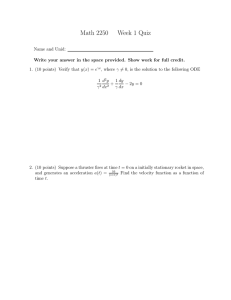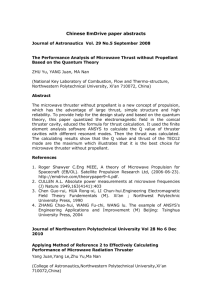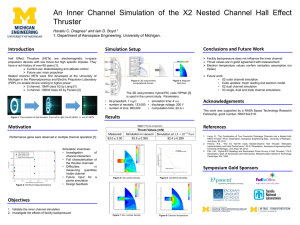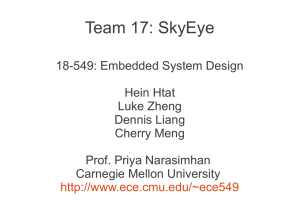Experimental characterization of HET and RIT with atmospheric
advertisement
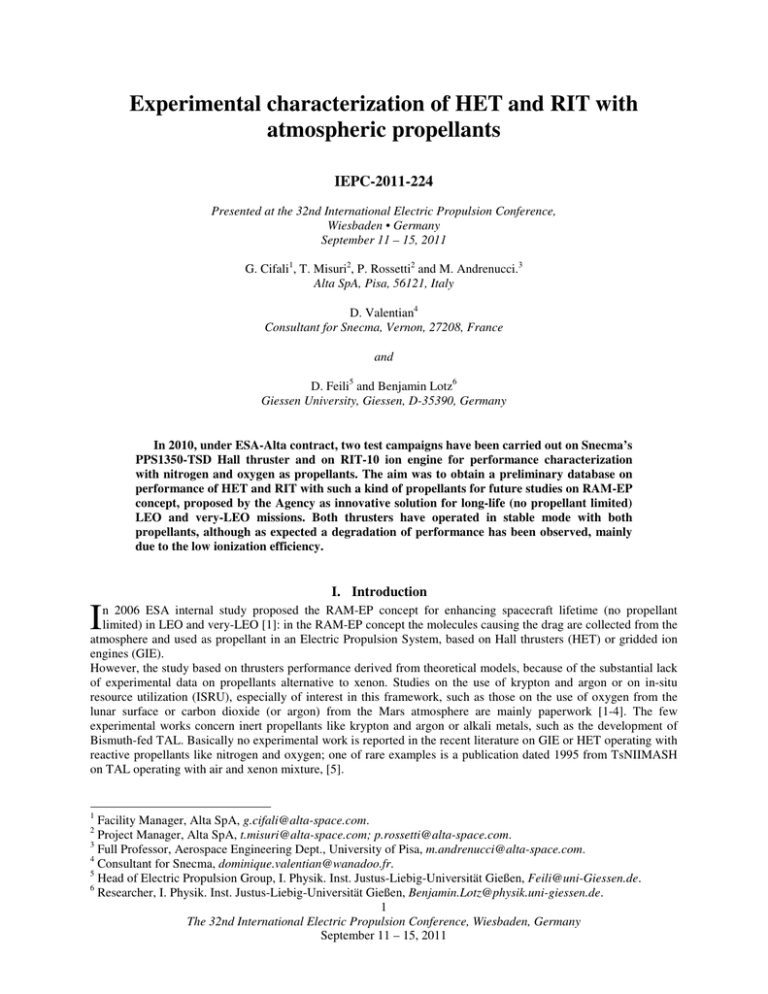
Experimental characterization of HET and RIT with atmospheric propellants IEPC-2011-224 Presented at the 32nd International Electric Propulsion Conference, Wiesbaden • Germany September 11 – 15, 2011 G. Cifali1, T. Misuri2, P. Rossetti2 and M. Andrenucci.3 Alta SpA, Pisa, 56121, Italy D. Valentian4 Consultant for Snecma, Vernon, 27208, France and D. Feili5 and Benjamin Lotz6 Giessen University, Giessen, D-35390, Germany In 2010, under ESA-Alta contract, two test campaigns have been carried out on Snecma’s PPS1350-TSD Hall thruster and on RIT-10 ion engine for performance characterization with nitrogen and oxygen as propellants. The aim was to obtain a preliminary database on performance of HET and RIT with such a kind of propellants for future studies on RAM-EP concept, proposed by the Agency as innovative solution for long-life (no propellant limited) LEO and very-LEO missions. Both thrusters have operated in stable mode with both propellants, although as expected a degradation of performance has been observed, mainly due to the low ionization efficiency. I I. Introduction n 2006 ESA internal study proposed the RAM-EP concept for enhancing spacecraft lifetime (no propellant limited) in LEO and very-LEO [1]: in the RAM-EP concept the molecules causing the drag are collected from the atmosphere and used as propellant in an Electric Propulsion System, based on Hall thrusters (HET) or gridded ion engines (GIE). However, the study based on thrusters performance derived from theoretical models, because of the substantial lack of experimental data on propellants alternative to xenon. Studies on the use of krypton and argon or on in-situ resource utilization (ISRU), especially of interest in this framework, such as those on the use of oxygen from the lunar surface or carbon dioxide (or argon) from the Mars atmosphere are mainly paperwork [1-4]. The few experimental works concern inert propellants like krypton and argon or alkali metals, such as the development of Bismuth-fed TAL. Basically no experimental work is reported in the recent literature on GIE or HET operating with reactive propellants like nitrogen and oxygen; one of rare examples is a publication dated 1995 from TsNIIMASH on TAL operating with air and xenon mixture, [5]. 1 Facility Manager, Alta SpA, g.cifali@alta-space.com. Project Manager, Alta SpA, t.misuri@alta-space.com; p.rossetti@alta-space.com. 3 Full Professor, Aerospace Engineering Dept., University of Pisa, m.andrenucci@alta-space.com. 4 Consultant for Snecma, dominique.valentian@wanadoo.fr. 5 Head of Electric Propulsion Group, I. Physik. Inst. Justus-Liebig-Universität Gießen, Feili@uni-Giessen.de. 6 Researcher, I. Physik. Inst. Justus-Liebig-Universität Gießen, Benjamin.Lotz@physik.uni-giessen.de. 1 The 32nd International Electric Propulsion Conference, Wiesbaden, Germany September 11 – 15, 2011 2 Therefore, ESA issued an Invitation to Tender for Preliminary characterization test campaign of Electric Propulsion technology with non conventional propellants and the corresponding contract was awarded to Alta at the end of 2009. The paper deals with the experimental campaigns carried out during 2010 on: - PPS1350-TSD Hall thruster representative of Snecma’s PPS 1350; the thruster was operated in Alta’s IV10 facility with pure nitrogen and with a mixture of oxygen and nitrogen. - RIT-10 Elegant Breadboard Model (EBBM) representative of ARTEMIS RIT-10, developed and tested at the University of Giessen, operated with pure nitrogen and pure oxygen. For both thrusters the test plan comprised an initial, quick characterization in xenon to verify the performance with respect to the corresponding reference thruster and a performance characterization test, followed by 10-h longfiring at fixed operating point for each atmospheric propellant. The characterization in xenon has been repeated at the end of each long-firing test to recheck performance after operation with such “aggressive” propellants. Test article, facility and main results for PPS1350-TSD and RIT-10 EBBM test campaigns are presented in section II and III respectively. II. HET test campaign HET test campaign has been carried out in Alta’s IV10 vacuum facility (Figure 1). Although optimized for working with xenon, the facility had excellent performance also with the atmospheric gases. During long-firing test with nitrogen for instance, the chamber pressure never exceeded 6.0e-6 mbar. The vacuum facility is well described in Ref. 6. The thruster has been mounted on a single-axis thrust stand, designed for this campaign to improve the sensitivity with respect to pre-existing Alta’s balance. In fact the thruster was expected to have a lower thrust with nitrogen/oxygen than with xenon. The measurement range is 5-300 mN, with a resolution of 1 mN and an accuracy of 1% F. S. Laboratory power supply and gas feeding systems have been Figure 1. IV10 vacuum facility at Alta provided. No beam diagnostics has been used; only the functional parameters of the thruster and the thrust have been measured continuously by the Experiment Control System (ECS). A detailed description of the test facilities used for this campaign can be found in Ref. 7. In order to limit anode oxidation, for the PPS1350-TSD the test with pure oxygen has been replaced by the test with a mixture of nitrogen and oxygen representative of the RAM-EP application. At this purpose, on the basis of the atmosphere composition at 200-km altitude according to ECSS-E-ST-10-04C, an equivalent molecular composition of 1.27N2 + O2 has been chosen. The PPS1350-TSD was always ignited with xenon. After ignition, a smooth transition from 100% xenon to 100% nitrogen or N2/O2 mixture at the anode was carried out; the cathode continued to work with xenon. The thruster has been operated with voltage and power limitations at 350 V and 1.4 kW respectively. A. Test article The selected Hall thruster is the PPS1350-TSD manufactured at Snecma during years 2004-2005 under ESA/Estec contract. With respect to PPS®1350 the thruster implemented four additional pole pieces and electromagnets and local xenon injectors and lines with the purpose of functioning as Thrust Steering Device. It was tested during several experimental campaigns in Alta’s IV4 vacuum facility for a cumulative operation time of nearly 554 hours. For the present test the PPS1350-TSD has been reconverted to the PPS®1350 configuration, removing the additional four poles and coils and xenon lines. No other part has been removed or changed. The thruster is shown in Figure 2. B. Test results with pure nitrogen As said before, at the beginning of the test campaign a quick characterization in xenon has been carried out in order to verify the performance with respect to PPS®1350. Figure 3 shows the obtained data in terms of electrical 2 The 32nd International Electric Propulsion Conference, Wiesbaden, Germany September 11 – 15, 2011 400 80 350 70 300 60 250 50 200 Thrust, mN Voltage, V characteristics and thrust. The performance is 4-5% lower than reference thruster probably due to the non-use of the rear coils and to the presence of the particular erosion patterns from the past tests as TSD device. 40 4.76 mg/s 4.21 150 30 3.75 3.3 2.86 100 20 2 2.5 3 3.5 4 4.5 Current, A Figure 2. The PPS1350-TSD Figure 3. Voltage (full marks) and thrust (empty marks) vs current for PPS1350-TSD with xenon. After this initial characterization in Xe, the test with nitrogen started. Figure 4 shows the PPS1350-TSD during operation with pure nitrogen at the anode. Figure 5 reports the thruster electrical characteristics at the explored flow rates. The electrical characteristics is not “vertical” as for xenon in Figure 3; in fact the current still increases with voltage as it is also for xenon before the curve approaches the vertical asymptote. This suggests that the nitrogen characteristics are shifted to higher voltages with respect to xenon. The computation of the ionisation efficiency shows that this last is lower for nitrogen than for xenon (at least for the analysed operating domain), that it increases with discharge voltage and is strongly non-linear. Figure 6 shows the thrust vs. discharge current characteristics at different nitrogen flow rates. From the measured parameters, the ratios Power/Thrust, Thrust/Current and Current/Mass Flow Rate have been computed. When the thruster operates at 305 V, Power-to-thrust ratio fulfills the requirement of the RAM-EP application; the operating point 305 V, 3.48 A, 41.6 W/mN is of particular interest. Taking this point as reference, Power-toThrust ratio increases with voltage with a rate steeper than the expected square root variation. This is probably due to a change of ion composition at higher voltages: it is suspected that atomic ions are more numerous at 350 V. This would be confirmed also by the increase of Current/Mass Flow Rate and by the decrease of Thrust/Current ratios at 350 V with respect to 305 V. At lower voltages, Power/Thrust does not improve and the discharge efficiency is probably lower. 3 The 32nd International Electric Propulsion Conference, Wiesbaden, Germany September 11 – 15, 2011 360 340 320 Voltage, V 300 280 260 2.85 mg/s 240 2.7 2.65 2.53 2.43 220 2.3 Figure 4. Thruster pure Nitrogen operating 200 with 1 1.5 2.5 3 3.5 4 4.5 Current, A Figure 5. Thruster nitrogen 30 electrical characteristics with For the long-firing test, the operating point has been chosen at 305 V and 3 A discharge current to get the most favorable power-to-thrust ratio and to limit the discharge power to approximately 1 kW, avoiding thruster overheating for larger powers. The operation was very stable during the 10 hours test. The thrust was always in the interval between 19 and 21 mN. 25 20 Thrust, mN 2 15 10 2.85 mg/s 2.7 2.65 2.53 2.43 5 2.3 0 1 1.5 2 2.5 3 3.5 4 4.5 Current, A Figure 6. Thrust vs. current at different nitrogen flow rates C. Test results with nitrogen/oxygen mixture Figure 7 shows the PPS1350-TSD during operation with nitrogen/oxygen mixture at the anode. Figure 8 and Figure 9 respectively show the discharge current and the measured thrust as a function of the mixture mass flow rate, with discharge voltage as a parameter. As for the test with pure nitrogen the electrical characteristic that can be inferred from Figure 8 is not vertical and is shifted to higher voltages with respect to xenon. With the mixture the ionisation efficiency is lower than with xenon (at least for the analysed operating domain) but equal or slightly superior to the pure nitrogen one, especially at low voltages. The ionisation efficiency increases slightly with discharge voltage and is more linear than in the case of pure nitrogen. From the computation of the main performance ratios it can be seen Figure 7. Thruster operating with N2/O2 mixture (305 V, 2.75 mg/s) 4 The 32nd International Electric Propulsion Conference, Wiesbaden, Germany September 11 – 15, 2011 that the thruster behaviour is similar in both cases, when it is fed with the mixture or with pure nitrogen. However, at low flow rates the discharge is still fairly efficient (more efficient than with pure nitrogen). Stable operation occurs with a mass flow rate as low as 2.1 mg/s. The thruster has operated stably during the 10 hours test. The measured thrust has been 24 mN, higher than with pure nitrogen (21 mN), even considering a correction factor for the slightly lower mass flow rate in the test with nitrogen (2.65 mg/s) than with the mixture (2.75 mg/s). As said before after each test phase with nitrogen and with mixture, the performance with xenon has been rechecked. The results in terms of thrust vs power at 350 V and different flow rates are reported in the graph in Figure 10. Performance in xenon have been substantially unaffected by operation with the atmospheric propellants. It should be noted that the shifting of the curve referring to xenon characterization after test with mixture to higher powers is probably due to operation at higher flow rates than set points due to perturbations on the flow controller induced by oscillations on the main discharge circuit. A visual inspection of the thruster has been carried out after the test in order to evaluate the effects of operation with nitrogen and oxygen, especially on the anode and on the ceramics. The anode seems “rusty” and this can be easily explained by the chemical reaction with oxygen. The signs of operation with oxygen are also visible on the ceramics, however with respect to a future endurance test the anode oxidation with the consequent increase in electrical resistance is the main concern. 5 350 V 305 263 220 Current, A 4 3 2 1 2 2.2 2.4 2.6 2.8 3 3.2 3.4 3.6 3.8 4 Flow rate, mg/s Figure 8. Current vs. flow rate with discharge voltage as parameter 5 The 32nd International Electric Propulsion Conference, Wiesbaden, Germany September 11 – 15, 2011 30 350 V 305 263 Thrust, mN 25 220 20 15 10 2 2.2 2.4 2.6 2.8 3 3.2 3.4 3.6 3.8 4 Flow rate, mg/s Figure 9. Thrust vs. flow rate with discharge voltage as parameter 100 80 Thrust, mN 60 40 Initial Post N2 test Post N2/O2 test 20 0 600 700 800 900 1000 1100 1200 1300 1400 1500 1600 Power, W Figure 10. Thrust vs. power with xenon at 350 V and 4.76 mg/s, 4.21 mg/s, 3.75 mg/s, 3.3 mg/s, 2.86 mg/s (only for Initial and Post N2 test). III. RIT test campaign The RIT test campaign has been carried out in the JUMBO test facility of the I. physics Institute of Giessen University, shown in Figure 11. A detailed description of this vacuum facility is reported in Ref. 7. Also in this case no beam diagnostics has been used, while the thrust has been directly measured by a thrust stand with a measurement range up to 800 mN and an absolute precision of about 1 mN. All required power supplies and the control computer are located in a bread board rack called "Test Power Supply" situated outside the vacuum chamber. The radio-frequency generator employed during the long run test has nearly reached the FM-model level. Consequently, it has been located in the vacuum chamber at a distance to the thruster which is representative for flight. 6 The 32nd International Electric Propulsion Conference, Wiesbaden, Germany September 11 – 15, 2011 A laboratory gas feeding system has been provided. The argon is used to ignite the thruster, as the ignition with N2/O2 was found to be much more difficult. The argon has a much lower ionisation energy and therefore needs lower pressures and electric field to start the self sustaining discharge (ignition). The same can be done with xenon. xenon ignites even better than argon. However, because of costs, argon has been chosen for ignition. The performance mapping of a Radio Frequency Ion Thruster are carried out as explained below. For a specific beam current, Ibeam, (which, in combination with a specific voltage, defines a specific thrust) the RF-power and mass flow are dependent on each other. This dependency Figure 11. Vacuum test facility Jumbo function is a characteristic of the thruster and the propellant. The performance mapping is the characterization of this dependency. Generally, for a specific thrust, the higher the gas flow, the lower is the power required. To keep Ibeam (thrust) constant, a Beam Current Controller or software can be used. The performance mapping of the RIT-10-EBB constructed for this activity has been done by variation of the mass flow rate while the beam current is held constant. The thruster has operated with 15-20 different mass flow rates for each beam current level among the following ones: 75mA, 100mA, 150mA, 200mA and 234mA. The potentials of the screen grid and of the acceleration grid have been kept constant at 1500 V and -600 V, respectively, for the entire test campaign. Each single operational point is to be operated until performance equilibrium is reached. Normally, the performance equilibrium is reached after few minutes. A. Test article An EBB model of the RIT-10 has been used in this test. This thruster is designed specifically for the tests on using atmospheric gases as propellant. The thruster is designed as a copy of the RIT-10-ARTEMIS with (nearly) the same performance. It has the same extraction area, the same ion optics, the same discharge chamber geometry and the same RF-discharge design. The main differences between the flight RIT-10 and RIT-10-EBB are in three points: 1. The RIT-10-EBB has a water cooling system, as higher power consumption and higher temperatures were expected for atmospheric propellants. 2. The extraction/acceleration system is designed to be very flexible, so the different grids can be mounted on the thruster easily. In future optimisation it will be necessary to change the ion optic, as a different optimal ion optic is expected for atmospheric gases than xenon. 3. The discharge chamber can be changed easily, so discharge chambers with different lengths can be mounted during future activities aiming to optimise the thruster design for operation with Figure 12. 3D-CAD view of RIT-10EBB ion thruster atmospheric propellants. 7 The 32nd International Electric Propulsion Conference, Wiesbaden, Germany September 11 – 15, 2011 B. Test results with pure nitrogen Also RIT-10EBB has been initially characterized in xenon. The corresponding results are shown in the following figures together with results of nitrogen and oxygen in order to highlight the differences in performance. Figure 13 shows the thruster during operation with nitrogen. Figure 14 and Figure 15 show respectively the RF power and the total power vs. the flow rate for both xenon and nitrogen. In the first figure the curves are parameterized with the beam current, while in the second one with the thrust level. It is obvious that the RIT-10 thruster needs a higher amount of gas and total power when operating with N2 in comparison to Xe and it delivers a lower thrust. At the power level of 450W of the ARTEMIS mission, the thruster can achieve 5.25 mN at optimal N2 gas flow of 8.514 sccm. The same thrust can be reached with lower gas flows (down to 6sccm) and higher powers or with higher gas flows (up to 10 Figure 13. RIT-10 thruster running sccm) and lower powers. with N2 In the long-firing test the thruster has been operated with a beam level of 150 mA and a flow rate of 9.89 sccm, for 10 hours continuously. During this test, the negative high voltage power supply has arced twice, which led to an automatic “Turn Off” of the Negative High Voltage. However, the thruster continued to run and there has no been beam out in this test. This shows that the RF-Generator can sustain the impedance change of the thruster by arcing. Based on measurements taken on the two grids before and after the test, all measured holes have unchanged diameter; any small deviation is below the precision of measurement, so no erosion can be observed. Figure 14. RF power vs flow rate with N2 (on the left) and with Xe (on the right) 8 The 32nd International Electric Propulsion Conference, Wiesbaden, Germany September 11 – 15, 2011 Figure 15. RIT-10 thruster performance curves with N2 and Xe C. Test results with pure oxygen A picture of the RIT-10-EBB operating with O2 is shown in Figure 16, while performance measured during this test is given in Figure 17 and in Figure 18. The RIT-10 thruster needs a higher amount of gas and total power when operating with O2 in comparison to Xe and delivers lower thrusts. The post-processing of the data shows that at optimal O2 gas flow and 450 W total power the thruster can achieve a thrust of about 6 mN. The same thrust can be also reached with lower gas flows (down to 6 sccm) and higher powers or with higher gas flows (up to 10scccm) and lower Figure 16. RIT-10 thruster running powers. with O2 Figure 19 shows the comparison between the performance curves of the thruster operating with oxygen and nitrogen. It shows that, as it was expected from the mass ratio of N2 and O2, the maximum achievable thrust is higher for oxygen than for nitrogen. As the ionisation energy of both gases is comparable, there is not a large difference between the power consumptions. During the tests with O2, a rising discrepancy between the thrust levels directly measured by the thrust balance and the calculated values has been observed. This discrepancy is higher at higher powers. It can be assumed that this behaviour is due to the dissociation of O2 into O. At higher rf-powers the electron energy is higher, so more dissociation is expected. With higher dissociation degrees, the thrust to beam energy ratio will be lower, as more ions come out of the thruster with half the mass. This effect has not been detected in nitrogen test, but the fact that the dissociation energy of the nitrogen molecules is higher than the one of oxygen molecules (9.8 eV for N2 comparison to 5.2eV for O2) can provide an explanation. For a quantitative and exact assessment of the phenomenon, an intensive beam diagnostics with mass and energy selective systems is necessary. After the characterization test, the thruster has operated at a beam level of 150 mA and a flow rate of 9.89 sccm, for 10 hours continuously. 9 The 32nd International Electric Propulsion Conference, Wiesbaden, Germany September 11 – 15, 2011 Figure 17. RIT-10 with O2 characterization results The grid erosion resulted noticeably higher than after test with nitrogen. As the sputtering rate of graphite under ion beams of oxygen and nitrogen is merely the same, the difference is probably due to chemical processes between graphite and oxygen. Figure 18. RIT-10 thruster performance curves with O2 and Xe 10 The 32nd International Electric Propulsion Conference, Wiesbaden, Germany September 11 – 15, 2011 Figure 19. Comparison between RIT-10 with N2 and O2 IV. Conclusion In the frame of an ESA project, a Hall thruster, the PPS1350-TSD, and an ion engine, the RIT-10 EBBM, have been experimentally characterized with nitrogen and oxygen in IV10 vacuum facility at Alta and in the Jumbo facility at Giessen University respectively. This represents one of the few works concerning testing of electric thrusters with propellants alternative to xenon and probably the first, at least in Europe, concerning atmospheric propellants. The test results show for both thrusters a substantial deterioration of performance with respect to Xe, especially due to the low ionization efficiency of the atmospheric propellants. However a long-firing test demonstrates that both devices are basically capable of continuous and stable operation with such kind of propellants. In addition measured performance are in the range of RAM-EP application. HET is preferable when a low Power/Thrust ratio is required, while RIT is more suitable when low thrust levels (<10 mN) are needed. From the experimental side, the activity will continue in the next months with a 500-hour (target) endurance test on both thrusters using the nitrogen/oxygen mixture representative of the ESA RAM-EP study case. Future experimental studies should also comprise investigation of beam composition and its variation with operating conditions. Present and future results will allow a preliminary assessment of the capability of the state-of-art electric propulsion technology to operate with atmospheric propellants. More important they can be used for modeling ionization and acceleration processes for such kind of propellants deriving more realistic performance for future RAM-EP mission studies. Finally the insight gained in the physics of HET and GIE operation with atmospheric propellants could serve for optimizing the design of such thrusters for the specific working gas. Acknowledgments The authors thank Mrs Davina Di Cara for her support and inputs as ESA technical officer for the project Preliminary characterization test campaign of Electric Propulsion technology with non conventional propellants. References 1 Di Cara, D., et al., “RAM Electric Propulsion for Low Earth Orbit Operation: an ESA study”, IEPC-2007-162, 30th International Electric Propulsion Conference, Florence, Italy, Sept. 17-20, 2007. 2 Conley, B. R., “Utilisation of ambient gas as a propellant for low earth orbit electric propulsion”, Degree thesis, MIT, 1995. 11 The 32nd International Electric Propulsion Conference, Wiesbaden, Germany September 11 – 15, 2011 3 Lamamy, J.-A., “Enhancing the science return of Mars missions via sample preparation, robotic surface exploration and in orbit fuel production”, Degree thesis, MIT, 2004. 4 Frisbee, R. H., et al., “Oxygen-propellant plasma thrusters for Cis-Lunar electric propulsion missions”, AIAA-1998-3994, AIAA/ASME/SAE/ASEE 34th Joint Propulsion Conference and Exhibit, Cleveland, OH, July 13-15, 1998. 5 Semenkin, A. V., et al., “Study of anode layer thruster operation with gas mixtures”, IEPC 95-78, 24th International Electric Propulsion Conference, Moscow, Russia, Sept. 19-23, 1995. 6 Saverdi, M., et al.“The IV10 Space Simulator for High Power Electric Propulsion Testing: Performance Improvements and Operation Status”, IEPC-2007-321, 30th International Electric Propulsion Conference, Florence, Italy, Sept. 17-20, 2007. 7 Rossetti, P., et al.“ Preliminary characterization test of HET and RIT with Nitrogen and Oxygen”, AIAA-2011-6073, 47th AIAA/ASME/SAE/ASEE Joint Propulsion Conference and Exhibit, San Diego, California, July 31-3, 2011. 12 The 32nd International Electric Propulsion Conference, Wiesbaden, Germany September 11 – 15, 2011

